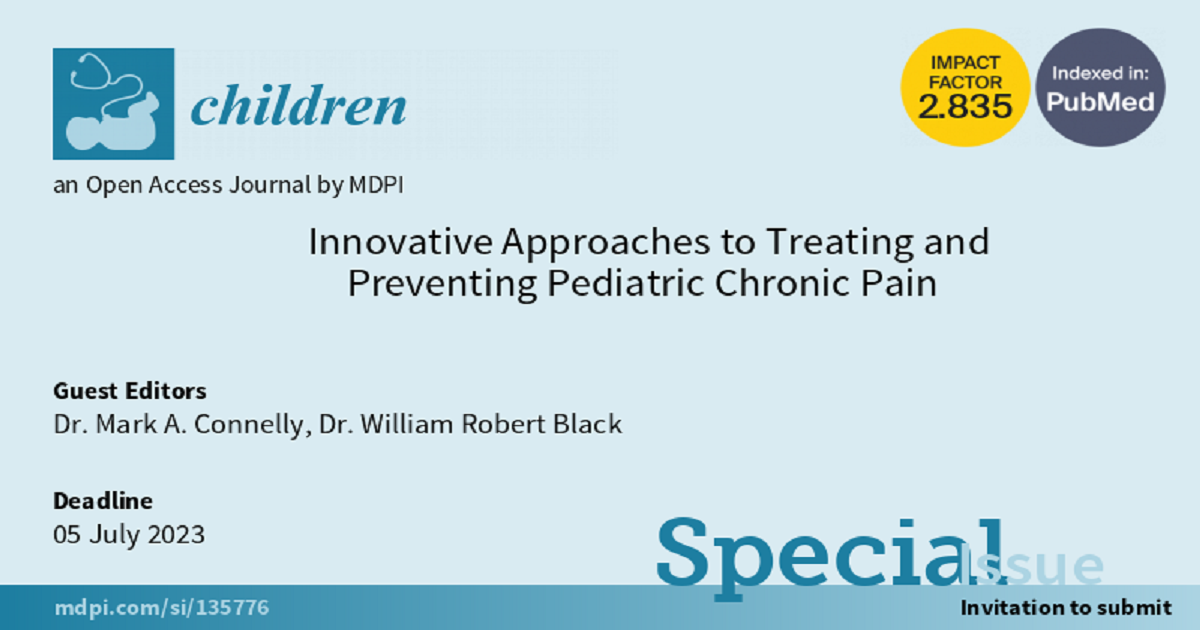Innovative Approaches to Treating and Preventing Pediatric Chronic Pain
A special issue of Children (ISSN 2227-9067). This special issue belongs to the section "Pediatric Anesthesiology, Perioperative and Pain Medicine".
Deadline for manuscript submissions: closed (5 July 2023) | Viewed by 16945

Special Issue Editors
Interests: pediatric psychology; pain; migraine and headache; digital health; health psychology/behavioral medicine; nonpharmacological therapies; adjustment to chronic illness
Special Issue Information
Dear Colleagues,
Chronic pain continues to be one of the most prevalent, disruptive, and costly problems experienced by children and adolescents worldwide. Although studies have shown that the symptoms and impact of chronic pain, on average, can improve with some treatment approaches (psychological, rehabilitative, integrative, and/or medical/pharmacological), treatment adherence and outcomes are highly variable, and known treatment effect sizes have remained small to moderate over time. Many young people struggling with chronic pain also never access formal treatment in current care models, and those that do often have complexities that do not easily fit into studied treatment protocols. To maximize effectiveness and accessibility, contemporary treatment of pediatric chronic pain requires creativity and innovation.
The aim of this Special Issue of Children is to communicate cutting-edge, novel, and transformative approaches to improving the efficacy and/or reach of pediatric chronic pain treatment. We invite original research across the spectrum of pediatric chronic pain conditions, on all types of interventions, and from any stage of intervention development and testing (early stage and formative research methods through efficacy and implementation studies), assuming appropriate methodological rigor. Although prioritizing original research, conceptual papers and reviews will be considered if they inform novel pediatric chronic pain treatment elements that are likely to have an impact on improving impact or reach.
Examples of invited work include, but are not limited to, studies that involve:
- Modifying established chronic pain treatments in novel ways to reach new or underserved pediatric populations or to improve treatment adherence or effects;
- Developing new treatment models and methods based on contemporary advances in understanding pediatric chronic pain mechanisms;
- Evaluating treatments intended to prevent pain chronification and secondary chronic pain conditions in children and adolescents;
- Innovative care models for improving pediatric chronic pain treatment access, adherence, and outcomes;
- Precision/personalized and adaptive treatment approaches;
- Digital therapeutics for chronic pain management.
Dr. Mark A. Connelly
Dr. William Robert Black
Guest Editors
Manuscript Submission Information
Manuscripts should be submitted online at www.mdpi.com by registering and logging in to this website. Once you are registered, click here to go to the submission form. Manuscripts can be submitted until the deadline. All submissions that pass pre-check are peer-reviewed. Accepted papers will be published continuously in the journal (as soon as accepted) and will be listed together on the special issue website. Research articles, review articles as well as short communications are invited. For planned papers, a title and short abstract (about 100 words) can be sent to the Editorial Office for announcement on this website.
Submitted manuscripts should not have been published previously, nor be under consideration for publication elsewhere (except conference proceedings papers). All manuscripts are thoroughly refereed through a single-blind peer-review process. A guide for authors and other relevant information for submission of manuscripts is available on the Instructions for Authors page. Children is an international peer-reviewed open access monthly journal published by MDPI.
Please visit the Instructions for Authors page before submitting a manuscript. The Article Processing Charge (APC) for publication in this open access journal is 2400 CHF (Swiss Francs). Submitted papers should be well formatted and use good English. Authors may use MDPI's English editing service prior to publication or during author revisions.
Keywords
- pediatric chronic pain
- children and adolescents
- treatment
- innovation
Benefits of Publishing in a Special Issue
- Ease of navigation: Grouping papers by topic helps scholars navigate broad scope journals more efficiently.
- Greater discoverability: Special Issues support the reach and impact of scientific research. Articles in Special Issues are more discoverable and cited more frequently.
- Expansion of research network: Special Issues facilitate connections among authors, fostering scientific collaborations.
- External promotion: Articles in Special Issues are often promoted through the journal's social media, increasing their visibility.
- e-Book format: Special Issues with more than 10 articles can be published as dedicated e-books, ensuring wide and rapid dissemination.
Further information on MDPI's Special Issue polices can be found here.







